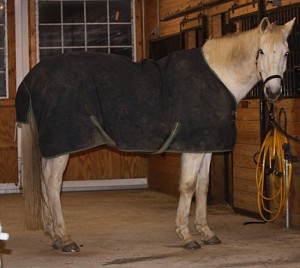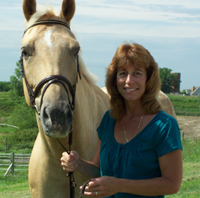 Cold weather presents horses with some specific nutritional and management demands. As winter approaches it is a good idea to evaluate horses, housing and feeding programs to insure that horses get through the cold weather in good shape.
Cold weather presents horses with some specific nutritional and management demands. As winter approaches it is a good idea to evaluate horses, housing and feeding programs to insure that horses get through the cold weather in good shape.
All warm-blooded animals have a critical temperature. This is the temperature below which the animal must produce additional heat to maintain normal body temperature. Mature horses in good flesh have a critical temperature around 30° F during early winter. After developing a winter coat and gaining 100 pounds, the critical temperature drops to 15° F. It is estimated that young horses, horses in thinner condition and those that have not developed a winter coat, may have a critical temperature around 40° F. When wet, windy conditions are present, the critical temperatures will be higher as well. In order to produce extra body heat, an increase in feed energy is required. Horses will require an estimated 15 – 20% more calories for each 10° F the ambient temperature falls below critical temperature. However, thin horses or horses with short hair may need even greater increases in dietary intake to maintain normal body temperature.
It is important that horses come into winter carrying enough body condition. The additional body fat serves as insulation and energy reserves in times when the thermometer dips below the critical temperature. Once cold weather sets in, it is difficult to put weight on horses. Thin horses get colder and use so much energy trying to stay warm, there often aren’t enough calories left for weight gain. Young horses and broodmares in late gestation, may not be able to consume enough of a high fiber diet, such as hay, due to restrictions in digestive system capacity. These horses must have access to good quality, highly digestible feeds in order to meet the additional energy requirements due to cold weather and higher production levels.
Historically, horsemen have often changed their rations from summer to winter to accommodate increased calorie needs. Typically, this is done by increasing the amount of hay and changing from oats to corn or a sweet feed. Feeding additional hay provides extra calories and also helps maintain body temperature due to the internal heat produced during digestion of fiber. The change from oats to corn or a sweet feed is based on the impression that corn or sweet feed is a “hotter” feed than oats. This concept of oats being a summer feed and corn a winter ration has some merit, but also has some flaws.
Nutritionally, oats and corn compare as follows:
Fiber,% Protein,%
Oats 10.7 11.8 1200
Corn 2.2 9.0 1500
One pound of corn has more energy and is lower in protein and fiber than one pound of oats. Not only does corn have more energy per pound than oats, corn also weighs more per unit of volume. One scoop full of corn has about 45% more calories than the same scoop full of whole oats. This has led to the idea that corn is a “hotter” feed than oats. Actually, because of the higher fiber level in oats, oats produce more internal heat during digestion than corn, it just takes more oats to provide enough calories.
Corn or oats alone can provide adequate calories but not adequate protein, vitamin or minerals. The best option for the horse year-round is a nutritionally balanced diet of good quality hay and a high-quality, well fortified commercial feed. During the winter months, provide as much shelter as possible, especially from wind and wet weather, and Calories/lb increase feed intake to help maintain body condition. Then as warmer weather arrives, continue to feed the nutritionally balanced diet, simply reduce the amount fed. When a well balanced feed is used, the only adjustments necessary are to increase or decrease the amount fed, depending on body condition or energy demand.
Monitoring water intake is another very important consideration during winter weather. Mature horses in temperate climates will normally drink from 5 – 8 gallons of water per day. Increasing the amount of hay in the diet will increase the water consumption, up to 9 or 10 gallons of water with an all-hay diet. During cold weather, water intake can decline dramatically. Increased hay intake combined with decreased water intake contributes to the risk of impaction colic. This is especially a problem when horses are kept in stalls for several days due to inclement weather because confinement tends to slow intestinal motility. In cold weather, water should be kept fresh and free of ice to insure adequate intake and horses exercised whenever possible. Also, adding one or two ounces of salt to the feed may stimulate water consumption.
By Karen E. Davison, Ph.D., Managing Equine Nutritionist, Purina Mills, LLC

